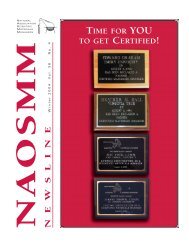Laboratory Safety Guidance
OSHA Lab Safety Guidance - ORS Optical Remote Sensing ...
OSHA Lab Safety Guidance - ORS Optical Remote Sensing ...
- No tags were found...
You also want an ePaper? Increase the reach of your titles
YUMPU automatically turns print PDFs into web optimized ePapers that Google loves.
dures for evaluating incidents, and determine a<br />
schedule for implementing the standard’s requirements,<br />
including engineering and work practice<br />
controls. The standard also requires employers to<br />
provide and pay for appropriate PPE for workers<br />
with occupational exposures. Although this standard<br />
only applies to bloodborne pathogens, the protective<br />
measures in this standard (e.g., ECP, engineering<br />
and work practice controls, administrative<br />
controls, PPE, housekeeping, training, post-exposure<br />
medical follow-up) are the same measures for<br />
effectively controlling exposure to other biological<br />
agents.<br />
The Personal Protective Equipment (PPE) standard<br />
(29 CFR 1910.132) requires that employers provide<br />
and pay for PPE and ensure that it is used wherever<br />
“hazards of processes or environment, chemical<br />
hazards, radiological hazards, or mechanical irritants<br />
are encountered in a manner capable of causing<br />
injury or impairment in the function of any part<br />
of the body through absorption, inhalation or physical<br />
contact.” [29 CFR 1910.132(a) and 1910.132(h)].<br />
In order to determine whether and what PPE is<br />
needed, the employer must “assess the workplace<br />
to determine if hazards are present, or are likely to<br />
be present, which necessitate the use of [PPE],”<br />
29 CFR 1910.132(d)(1). Based on that assessment,<br />
the employer must select appropriate PPE (e.g., protection<br />
for eyes, face, head, extremities; protective<br />
clothing; respiratory protection; shields and barriers)<br />
that will protect the affected worker from the hazard,<br />
29 CFR 1910.132 (d)(1)(i), communicate selection<br />
decisions to each affected worker, 29 CFR<br />
1910.132 (d)(1)(ii), and select PPE that properly fits<br />
each affected employee, 29 CFR 1910.132(d)(1)(iii).<br />
Employers must provide training for workers who<br />
are required to use PPE that addresses when and<br />
what PPE is necessary, how to wear and care for<br />
PPE properly, and the limitations of PPE, 29 CFR<br />
1910.132(f).<br />
The Eye and Face Protection standard (29 CFR<br />
1910.133) requires employers to ensure that each<br />
affected worker uses appropriate eye or face protection<br />
when exposed to eye or face hazards from flying<br />
particles, molten metal, liquid chemicals, acids<br />
or caustic liquids, chemical gases or vapors, or<br />
potentially injurious light radiation, 29 CFR<br />
1910.133(a).<br />
The Respiratory Protection standard (29 CFR<br />
1910.134) requires that a respirator be provided to<br />
each worker when such equipment is necessary to<br />
protect the health of such individual. The employer<br />
must provide respirators that are appropriate and<br />
suitable for the purpose intended, as described in 29<br />
CFR 1910.134(d)(1). The employer is responsible for<br />
establishing and maintaining a respiratory protection<br />
program, as required by 29 CFR 1910.134(c),<br />
that includes, but is not limited to, the following:<br />
selection of respirators for use in the workplace;<br />
medical evaluations of workers required to use respirators;<br />
fit testing for tight-fitting respirators; proper<br />
use of respirators during routine and emergency situations;<br />
procedures and schedules for cleaning, disinfecting,<br />
storing, inspecting, repairing and discarding<br />
of respirators; procedures to ensure adequate<br />
air quality, quantity, and flow of breathing air for<br />
atmosphere-supplying respirators; training of workers<br />
in respiratory hazards that they may be exposed<br />
to during routine and emergency situations; training<br />
of workers in the proper donning and doffing of respirators,<br />
and any limitations on their use and maintenance;<br />
and regular evaluation of the effectiveness<br />
of the program.<br />
The Hand Protection standard (29 CFR 1910.138),<br />
requires employers to select and ensure that workers<br />
use appropriate hand protection when their<br />
hands are exposed to hazards such as those from<br />
skin absorption of harmful substances; severe cuts<br />
or lacerations; severe abrasions; punctures; chemical<br />
burns; thermal burns; and harmful temperature<br />
extremes, 29 CFR 1910.138(a). Further, employers<br />
must base the selection of the appropriate hand<br />
protection on an evaluation of the performance<br />
characteristics of the hand protection relative to the<br />
task(s) to be performed, conditions present, duration<br />
of use, and the hazards and potential hazards<br />
identified, 29 CFR 1910.138(b).<br />
The Control of Hazardous Energy standard (29 CFR<br />
1910.147), often called the “Lockout/Tagout” standard,<br />
establishes basic requirements for locking<br />
and/or tagging out equipment while installation,<br />
maintenance, testing, repair, or construction operations<br />
are in progress. The primary purpose of the<br />
standard is to protect workers from the unexpected<br />
energization or startup of machines or equipment,<br />
or release of stored energy. The procedures apply to<br />
the shutdown of all potential energy sources associated<br />
with machines or equipment, including pressures,<br />
flows of fluids and gases, electrical power,<br />
and radiation.<br />
In addition to the standards listed above, other<br />
OSHA standards that pertain to electrical safety<br />
6<br />
Occupational <strong>Safety</strong> and<br />
Health Administration



